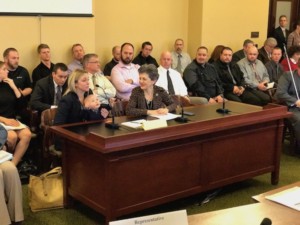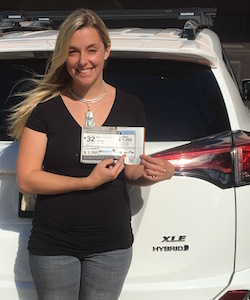By Ashley Miller for EDRBlog.org
 I was all set to start learning on the first day of the Environmental Dispute Resolution (EDR) Program’s Short Course on Effective Natural Resources Collaboration. The course piqued my interest since much of the work I do in the air quality field as the Policy Director for Breathe Utah would rely on enhancing my collaboration and conflict resolution skills. In previous legal work I had experience with conflict resolution, but as I became more engaged in Utah’s environmental issues, I felt that I needed to learn how to focus on the nexus of where community and health needs intersect business and industry objectives. I saw this course as an opportunity to hone in my techniques in collaboration and negotiation through a critiqued process. I was also intrigued by the unique opportunity to network with the diverse group of students that had been carefully selected by the program’s directors. By lunch on the first day, a classmate who works at Snowbird Resort and I had already generated an idea for a carpooling collaboration. Since the class has a “no screens” policy, I snuck my phone into the hallway and contacted my colleagues with the message: “New project in the works. Class going well!”
I was all set to start learning on the first day of the Environmental Dispute Resolution (EDR) Program’s Short Course on Effective Natural Resources Collaboration. The course piqued my interest since much of the work I do in the air quality field as the Policy Director for Breathe Utah would rely on enhancing my collaboration and conflict resolution skills. In previous legal work I had experience with conflict resolution, but as I became more engaged in Utah’s environmental issues, I felt that I needed to learn how to focus on the nexus of where community and health needs intersect business and industry objectives. I saw this course as an opportunity to hone in my techniques in collaboration and negotiation through a critiqued process. I was also intrigued by the unique opportunity to network with the diverse group of students that had been carefully selected by the program’s directors. By lunch on the first day, a classmate who works at Snowbird Resort and I had already generated an idea for a carpooling collaboration. Since the class has a “no screens” policy, I snuck my phone into the hallway and contacted my colleagues with the message: “New project in the works. Class going well!”
I remember thinking: “If this is how the remaining sessions are going to go, this will be the best class I’ve ever enrolled in!” And everything was going smoothly… until the daunting task of nailing down a Capstone Project arose.
Get notified when new articles are posted to the EDR blog – sign up for our email list »
Each student in the Short Course is required to complete an applied Capstone Project that puts the skills they are learning in the course into action in the real world. As I started forming my Capstone Project, I realized that coming into the course, I thought collaboration was the easy part. Everything I was doing for Breathe Utah was “collaborative.” Isn’t “collaboration” what we do best? In fact, it’s in Breathe Utah’s logo: Education, Collaboration, Policy. It’s how we get things done. But the Short Course soon taught me there is a lot more to a collaborative process than simply working with others on issues of mutual concern.
I wanted my Capstone Project to be centered on work that was already in process. Breathe Utah had for some time been discussing the idea of an effective way to reduce vehicle emissions, and it involved a vehicle’s smog rating. The window sticker on a vehicle for sale has an informative EPA label. Within this label is a smog rating, a number on a scale of 1-10 that reflects vehicle tailpipe emissions that contribute to local and regional air pollution, creating problems such as smog, haze, and health issues. Vehicles that score a 10 are the cleanest. Now, there is a lot to a smog rating, but ultimately we wanted to embark on an educational campaign to let consumers in Utah know that they have the power to contribute to cleaner air in Utah by choosing a vehicle based on it’s impact on our air shed. Breathe Utah partnered with Utah Clean Cities and Salt Lake City Sustainability and was awarded a grant from UCAIR (Utah Clean Air Partnership) to do just that. Collectively, we wanted to educate dealerships and salespeople on smog ratings so that in a sales negotiation a smog rating would be discussed right alongside miles per gallon. And so I thought this public education effort would be my Capstone Project.
The first step in the Capstone Project process is to conduct what is called a “Situation Assessment.” And, to put it lightly, doing my assessment was a major learning experience. My mentor, EDR Program Director Danya Rumore, wrote in the first line of her feedback of my draft Situation Assessment protocol: “The word ‘force’ indicates this isn’t collaborative.” I also learned that public education is more along the lines of “inform” rather than “collaborate,” as explained by the International Association for Public Participation (IAP2) Spectrum of Public Participation. Was I way off track?
Through the process of conducting the Situation Assessment, I learned that I was stuck in my ways of being an advocate for clean air. I also learned that for me to truly be “collaborative,” this advocacy-group-voice needed to be tweaked a little. I needed to step back and focus on bringing people together to address the “issue of mutual concern,” the problem or opportunity that can bring people together—in this case, protecting and improving air quality. As the IAP2 Spectrum shows, this kind of collaboration is very different from just sharing information with the public.
Through developing my Capstone Project, I realized I needed to focus on helping key stakeholders work together on reducing vehicle emissions to improve air quality, not telling them what to do. It hadn’t occurred to me that the outcome I wanted might not be the best solution to addressing vehicle emissions (although I still truly believe cleaner vehicles with higher smog ratings are part of the solution, and part of the pathway to continued improvement in air quality, especially considering vehicle emissions make up about half of our air pollution on an average day).
But this still left me with many questions. Should I focus on looking at dealerships? Or should I be thinking more broadly? What was something that everyone at the table could get behind? Was I trying to “force” people into selling and buying vehicles with a smog rating of 8 or higher? My partners and I convened several meetings with key stakeholders including scientists and planning specialists from the state Division of Air Quality, representatives from the New Car Dealers of Utah, and fellow clean air advocates.
I continued exploring the opportunity for a collaborative approach to utilizing a smog rating. Breathe Utah had presented the idea to the Clean Air Caucus over the summer, and Representative Patrice Arent opened a bill file for House Concurrent Resolution 18. Representative Arent received input for the language in the resolution from many of the stakeholders we had convened. The resolution encourages Utahns to consider a smog rating and other environmental impacts when purchasing a vehicle. It garnered the support of 46 members of the Utah House of Representatives as co-sponsors. The resolution passed, and we were proud to support this resolution throughout the legislative session as the first step in a statewide educational campaign surrounding smog ratings and what they mean for our air quality.
The passage of HCR 18 laid a great foundation for our UCAIR grant, and was a great accomplishment to present at my final day for the Short Course. While I was presenting I found myself in a constant state of “aha” moments thinking about where things went wrong with other pieces of legislation that I had worked on, and ways to take a more collaborative approach next session.
Completing the Short Course has continued to drive my efforts in a collaborative manner, both in my professional and personal life. As a result, I am much better able to identify commonality within the diverse perspectives that I come across daily. Utah is such a beautiful and unique state, and with a little more collaboration, I see an opportunity to overcome many of the challenges presented within our treasured natural resources.
 Ashley Miller is an attorney originally from Lake Tahoe, California. She is the Policy Director for the local non-profit air quality advocacy group, Breathe Utah. Her passions run deep in all things outdoors, like skiing and mountain biking. Ashley was recently appointed by Governor Herbert to the new Air Quality Policy Advisory Board. She is also a member of the Salt Lake County Health Department Environmental Quality Advisory Commission, and the Volkswagen Environmental Mitigation Plan Advisory Committee.
Ashley Miller is an attorney originally from Lake Tahoe, California. She is the Policy Director for the local non-profit air quality advocacy group, Breathe Utah. Her passions run deep in all things outdoors, like skiing and mountain biking. Ashley was recently appointed by Governor Herbert to the new Air Quality Policy Advisory Board. She is also a member of the Salt Lake County Health Department Environmental Quality Advisory Commission, and the Volkswagen Environmental Mitigation Plan Advisory Committee.
